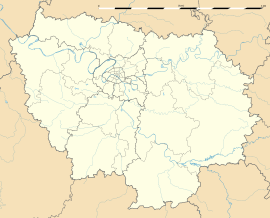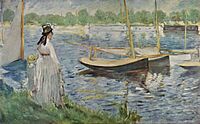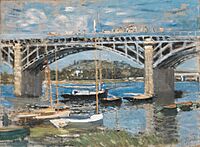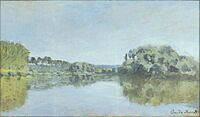Argenteuil facts for kids
Quick facts for kids
Argenteuil
|
||
|---|---|---|
|
Subprefecture and commune
|
||
![The Basilica of Argenteuil [fr]](/images/thumb/0/01/Basilique_d%27Argenteuil_-_chevet.jpg/250px-Basilique_d%27Argenteuil_-_chevet.jpg)
The Basilica of Argenteuil
|
||
|
||

Location (in red) within Paris inner and outer suburbs
|
||
| Country | France | |
| Region | Île-de-France | |
| Department | Val-d'Oise | |
| Arrondissement | Argenteuil | |
| Canton | Argenteuil-1 Argenteuil-2 Argenteuil-3 |
|
| Intercommunality | Métropole du Grand Paris EPT Boucle Nord Seine |
|
| Area
1
|
17.22 km2 (6.65 sq mi) | |
| Population
(2021)
|
107,221 | |
| • Density | 6,226.5/km2 (16,127/sq mi) | |
| Time zone | UTC+01:00 (CET) | |
| • Summer (DST) | UTC+02:00 (CEST) | |
| INSEE/Postal code |
95018 /95100
|
|
| Elevation | 21–167 m (69–548 ft) | |
| 1 French Land Register data, which excludes lakes, ponds, glaciers > 1 km2 (0.386 sq mi or 247 acres) and river estuaries. | ||
Argenteuil is a large town located in the northwestern suburbs of Paris, France. It is about 12.3 kilometers (7.6 miles) away from the very center of Paris. Argenteuil is an important administrative center, known as a sub-prefecture, within the Val-d'Oise department. It is also part of a larger urban area called the Métropole du Grand Paris.
Argenteuil is the fourth biggest town in the suburbs of Paris by population. Only Boulogne-Billancourt, Saint-Denis, and Montreuil are larger. It is also the most populated town in the Val-d'Oise department. However, the main administrative city (prefecture) for Val-d'Oise is shared between Cergy and Pontoise. Argenteuil shares its borders with towns in three other departments: Yvelines, Hauts-de-Seine, and Seine-Saint-Denis.
Contents
What Does the Name Argenteuil Mean?
The name Argenteuil was first written down in a royal document in 697. It was called Argentoialum back then. This name comes from a mix of Latin and Gaulish words. Argento means "silver," "silvery," or "shiny." This might refer to how the Seine river, which flows by Argenteuil, looks shiny. The second part, -ialo, is a Gaulish language suffix meaning "clearing," "glade," or "place of." So, the name likely means "silvery place" or "place by the shiny river."
A Brief Look at Argenteuil's History
Argenteuil started as a convent in the 600s. A convent is a community where religious women, called nuns, live and pray. This religious community later grew into a monastery. However, this monastery was destroyed during the French Revolution, a major historical event in France.
For a long time, Argenteuil was a quiet countryside spot where people from Paris would go to relax. But over time, it grew and became a busy suburb of Paris. Argenteuil also became famous because many well-known painters visited and painted its landscapes. These artists include Claude Monet, Eugène Delacroix, Auguste Renoir, Gustave Caillebotte, Alfred Sisley, and Georges Braque.
How to Get Around Argenteuil
Argenteuil is well-connected by public transport, making it easy to travel to and from Paris and other nearby towns.
Train and Bus Services
You can use two train stations in Argenteuil on the Transilien Paris-Saint-Lazare suburban rail line:
- Argenteuil station
- Val d'Argenteuil station
A new train line was started in 2006, connecting Paris-Saint Lazare to Ermont-Eaubonne. This line also offers services to Cormeilles-en-Parisis, Pontoise, and Mantes-la-Jolie, with trains running about every ten minutes to Paris.
There are also several bus lines:
- 361: From Argenteuil station to Pierrefitte - Stains RER station
- 140: From Argenteuil station to Asnières-Gennevilliers - Gabriel Péri
- 164: From Argenteuil - Claude Monet College to Porte de Champerret
Travel Times by Train
- From Gare d'Argenteuil (SNCF-J):
- Paris Saint-Lazare: about 15 minutes
- Colombes: about 4 minutes
- From Gare Saint-Gratien (T-8):
- Porte Maillot: about 22 minutes
- From Épinay Orgemont (T-8):
- Gare Saint-Denis: about 20 minutes
Driving Times by Car
- To the city center: about 10 minutes
- To Paris Saint-Lazare: about 25 minutes
- To La Défense: about 20 minutes
- To Colombes: about 10 minutes
- To la Plaine-Saint-Denis: about 18 minutes
- To Porte de Clichy: about 15 minutes
Learning and Education in Argenteuil
As of 2016, more than 12,000 students attend schools in Argenteuil. The town has a wide range of schools for all ages:
- 30 public preschools and one private elementary school with a preschool section.
- 26 public and 2 private elementary schools.
- 11 junior high schools (called collèges in France), with 10 public and 1 private.
- 6 senior high schools or sixth-form colleges:
- Lycée Georges Braque
- Lycée Cognacq-Jay
- Lycée Julie-Victoire Daubié
- Lycée Jean Jaurès
- Lycée Fernand et Nadia Léger
- Ecole nationale des professions de l'automobile (a private school)
For higher education, Paris 13 University serves students in the area. Argenteuil also has a special school for music, dance, and theater called the Conservatoire à rayonnement départemental. A famous former student of this conservatoire is André Bon.
How Many People Live in Argenteuil?
The population of Argenteuil has changed a lot over the years. The table below shows how the number of people living in the town has grown or shrunk since 1793.
| Historical population | |||||||||||||||||||||||||||||||||||||||||||||||||||||||||||||||||||||||||||||||||||||||||||||||||||||||||||||||||||
|---|---|---|---|---|---|---|---|---|---|---|---|---|---|---|---|---|---|---|---|---|---|---|---|---|---|---|---|---|---|---|---|---|---|---|---|---|---|---|---|---|---|---|---|---|---|---|---|---|---|---|---|---|---|---|---|---|---|---|---|---|---|---|---|---|---|---|---|---|---|---|---|---|---|---|---|---|---|---|---|---|---|---|---|---|---|---|---|---|---|---|---|---|---|---|---|---|---|---|---|---|---|---|---|---|---|---|---|---|---|---|---|---|---|---|---|
|
|
||||||||||||||||||||||||||||||||||||||||||||||||||||||||||||||||||||||||||||||||||||||||||||||||||||||||||||||||||
| Source: EHESS and INSEE (1968–2017) | |||||||||||||||||||||||||||||||||||||||||||||||||||||||||||||||||||||||||||||||||||||||||||||||||||||||||||||||||||
Where Do People Come From?
The table below shows where the people living in Argenteuil came from in 1999.
- Metropolitan France means people born in mainland France.
- Outside metropolitan France means people born outside mainland France. This group is then broken down further.
- Overseas France refers to French territories outside of mainland Europe.
- Foreign French means people who were born outside France but became French citizens.
- EU-15 refers to people from countries that were part of the European Union before 2004.
- Non-EU-15 refers to people from countries outside that group.
| Born in metropolitan France | Born outside metropolitan France | |||
|---|---|---|---|---|
| 77.5% | 22.5% | |||
| Born in overseas France |
Born in foreign countries with French citizenship at birth1 | EU-15 immigrants2 | Non-EU-15 immigrants | |
| 2.1% | 2.1% | 4.3% | 14.0% | |
| 1 This group is made up largely of former French settlers, such as pieds-noirs in Northwest Africa, followed by former colonial citizens who had French citizenship at birth (such as was often the case for the native elite in French colonies), as well as to a lesser extent foreign-born children of French expatriates. A foreign country is understood as a country not part of France in 1999, so a person born for example in 1950 in Algeria, when Algeria was an integral part of France, is nonetheless listed as a person born in a foreign country in French statistics. 2 An immigrant is a person born in a foreign country not having French citizenship at birth. An immigrant may have acquired French citizenship since moving to France, but is still considered an immigrant in French statistics. On the other hand, persons born in France with foreign citizenship (the children of immigrants) are not listed as immigrants. |
||||
Twin Towns and Sister Cities
Argenteuil has special partnerships with other cities around the world. These are called "twin towns" or "sister cities." They work together on cultural exchanges and other projects.
 Alessandria, Italy
Alessandria, Italy Dessau-Roßlau, Germany
Dessau-Roßlau, Germany Hunedoara, Romania
Hunedoara, Romania West Dunbartonshire, Scotland, United Kingdom
West Dunbartonshire, Scotland, United Kingdom
Famous People from Argenteuil
Many notable people have connections to Argenteuil:
- Héloïse (around 1100–1164), a nun, philosopher, and writer.
- Charles Longuet (1839–1903), a journalist and socialist activist.
- Claude Monet (1840–1926), a famous painter who lived and worked here from 1871 to 1878.
- Georges Braque (1882–1963), a painter, sculptor, and one of the founders of cubism.
- Sidney Duteil (born 1955), a musician and television host.
- Ingrid Chauvin (born 1971), an actress.
- Thomas Henry (born 1994), a professional footballer.
- Franck Béria (born 1983), a retired professional footballer and official.
- Ibrahim Gary (born 1985), a karate athlete.
- Fabien Ateba (born 1991), a basketball player.
- Kevin Mayer (born 1992), an athlete and Olympic medalist.
- Cécile Pelous, a philanthropist and designer.
- Laurina Fazer (born 2003), a footballer for the French national team.
Famous Paintings Inspired by Argenteuil
Argenteuil's beautiful scenery has been captured in many famous paintings, especially by Impressionist artists.

Paintings by Claude Monet
Claude Monet, a key figure in the Impressionist art movement, painted many scenes of Argenteuil, including:
- Autumn at Argenteuil
- Regatta at Argenteuil
- Red Boats, Argenteuil
- The Bridge at Argenteuil
- The Port at Argenteuil
- The Seine at Argenteuil
- View of Argenteuil-Snow
- Bords de la Seine a Argenteuil
- Snow at Argenteuil
- Train in snow at Argenteuil
Paintings by Other Artists
Other famous painters also created works inspired by Argenteuil:
- Argenteuil and Seine near Argenteuil by Édouard Manet.
- Regatta at Argenteuil by Pierre-Auguste Renoir.
- The Bridge in Argenteuil by Gustave Caillebotte.
Gallery of Argenteuil Paintings
See also
 In Spanish: Argenteuil para niños
In Spanish: Argenteuil para niños










